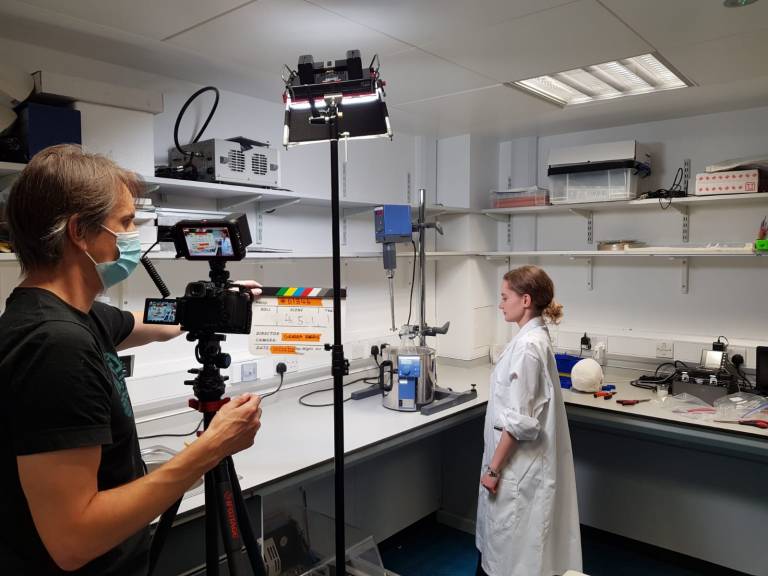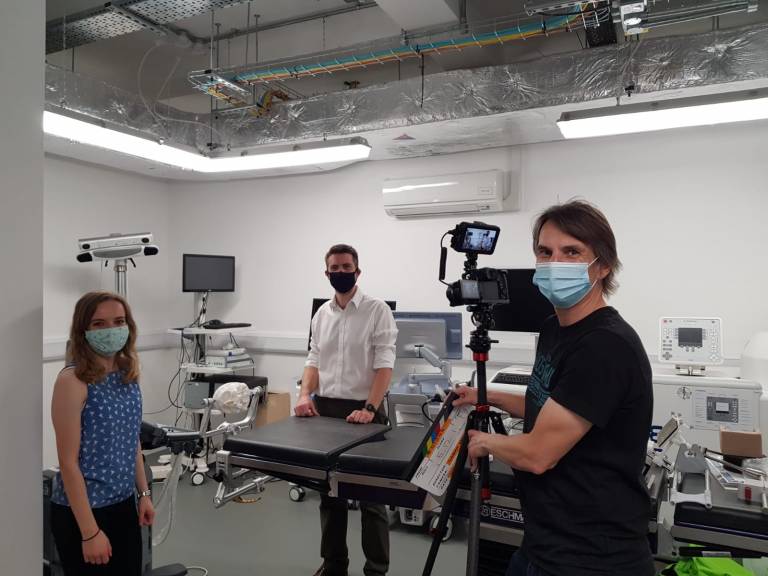Producing a Video Publication with JoVE
15 January 2021
WEISS PhD student Eleanor Mackle describes her recent experience of producing a video publication with JoVE

The Journal of Visualized Experiments (JoVE) is a unique journal because all of its papers are accompanied by a video. This makes it the ideal place to publish practical or lab-based work, because the authors can demonstrate methods that are hard to explain in words, and it really brings the research to life.
I am sure anyone from the Life Sciences is well acquainted with the journal, as it is a gold mine for lab protocols. In my experience, it is less well-known in Biomedical Engineering, but there are still many relevant publications. A protocol from UCL, published in 2016, explains how to characterise the biomechanical properties of human soft tissue. Another, more recent video, demonstrates how to segment lung CT scans, for assessment of COVID-19.
Recently, I published a protocol in JoVE, in collaboration with Dr Jonathan Shapey, for creating patient-specific brain phantoms. For this study, having a video alongside the paper was almost vital because it was difficult to give a clear explanation of the novel fabrication technique if the reader could not visualise the steps. Therefore, JoVE was the perfect place to publish the method, and I enjoyed doing something a bit different with my work. Here, I will outline the (surprisingly simple) process of creating a video publication for the journal.
The first step is similar to any other paper submission. The only difference is that everything in the methods section has to be detailed explicitly, in a step-by-step manner, so that it is easy for other researchers to replicate. Articles are peer reviewed in the usual way, although there is more leniency about the work being published elsewhere. As the focus of JoVE articles is on the detailed methods section, many of the publications are works that have recently been published elsewhere, but with a focus on the results or novelty, rather than the specific protocols used.
Once the paper has been accepted for publication, the fun part begins and the author is contacted by the production department to begin working on the video. The authors are asked to fill in a questionnaire, to help the scriptwriter understand which parts of the protocol are important to highlight. It is then used, alongside the submitted paper, to produce a draft script for the video. This includes short interview style snippets with the authors, as well as shots of the experimental procedure.
As an author, there are multiple opportunities throughout the scripting process to give feedback and make adjustments, which makes it easy to showcase exactly what you have in mind. The finalised script is then used to produce a shot list for the videographer, which can also be used by the authors to prepare everything for filming.

The filming day seems quite daunting – so many things could go wrong! – but the videographers are so experienced that they can handle anything and are very efficient. I think preparation is key, as it is likely that many things will have to be prepared in advance for those "here is one I made earlier" moments. Once the awkward part of having to speak to the camera is over, the rest of the day is just following the simple steps from the shot list.
Finally, the rough cut of the video is sent to authors for approval, with another opportunity to make suggestions. The final video is then uploaded to the website, to sit alongside the paper. For my video, the most time-consuming part of the process was providing screen captures of the computer-based aspects of the protocol, such as segmenting the data. However, the script detailed the exact shots I needed to produce, which made it easier, and the JoVE team were very helpful; they even had their own protocol video of how to use the screen capture software.
When working with JoVE, I was surprised to find out that everyone involved in the process – from the scriptwriters to the videographer – was a PhD level scientist themselves. This resulted in the process being smoother than I anticipated, because everybody understood the general concepts I was trying to show, and was on the same wavelength as me. It was also useful to have a fresh pair of eyes on the filming day - when the work is your own it can be tricky to work out what will and will not make sense to other researchers.
Overall, I would definitely recommend working with JoVE to produce a video publication, if it would be useful or relevant for your work. The whole process was less intimidating and time consuming than I expected it to be, and I think the end result presents my work in a much clearer way than I could have hoped to achieve with a paper alone – even if it is hideously embarrassing seeing yourself on camera!
 Close
Close

